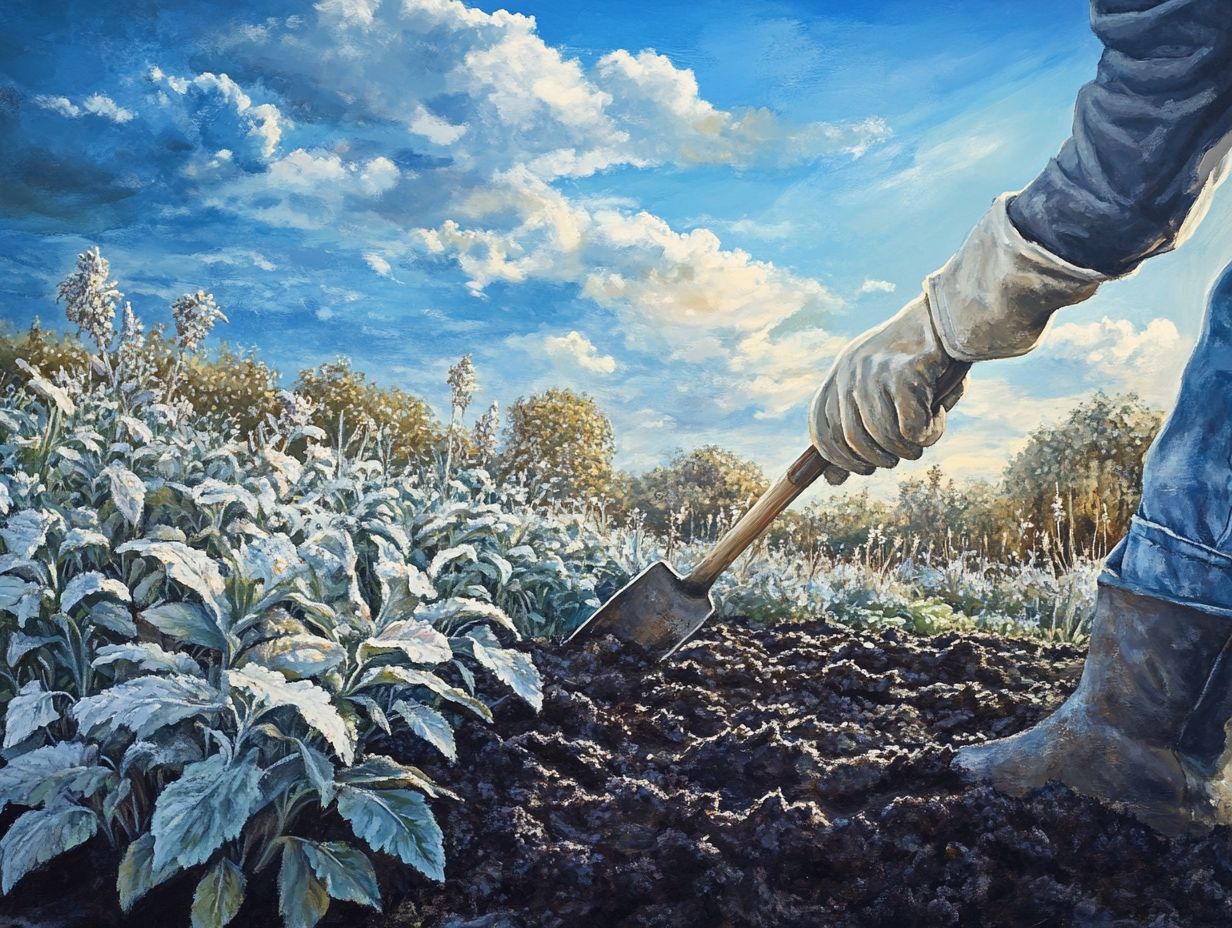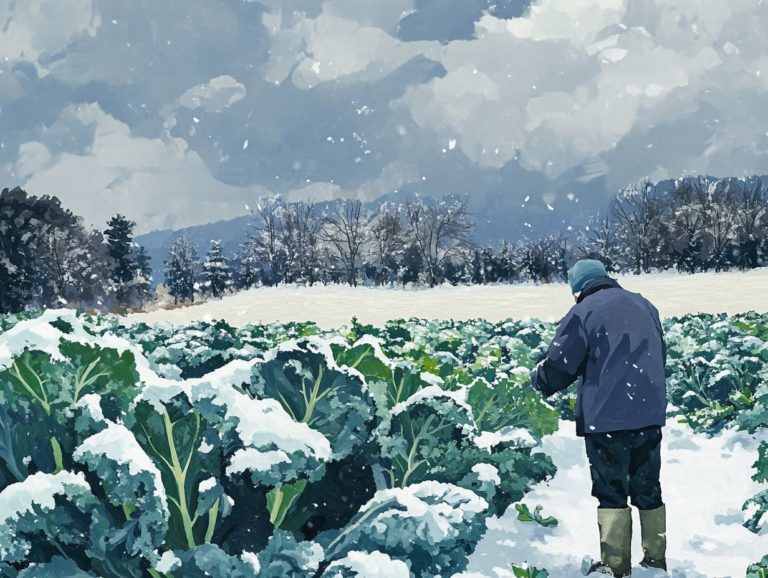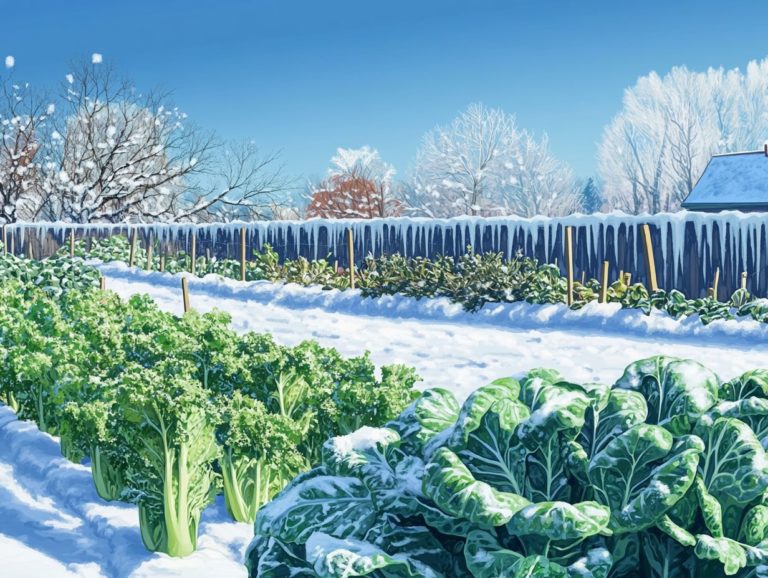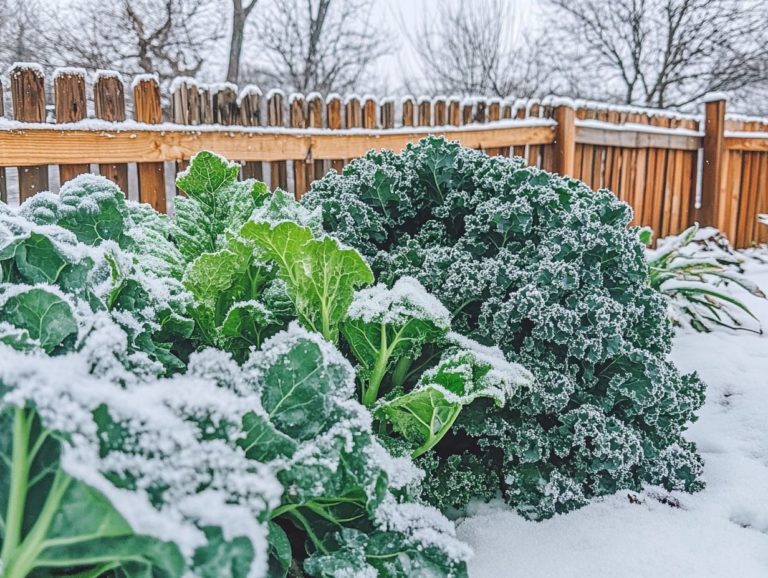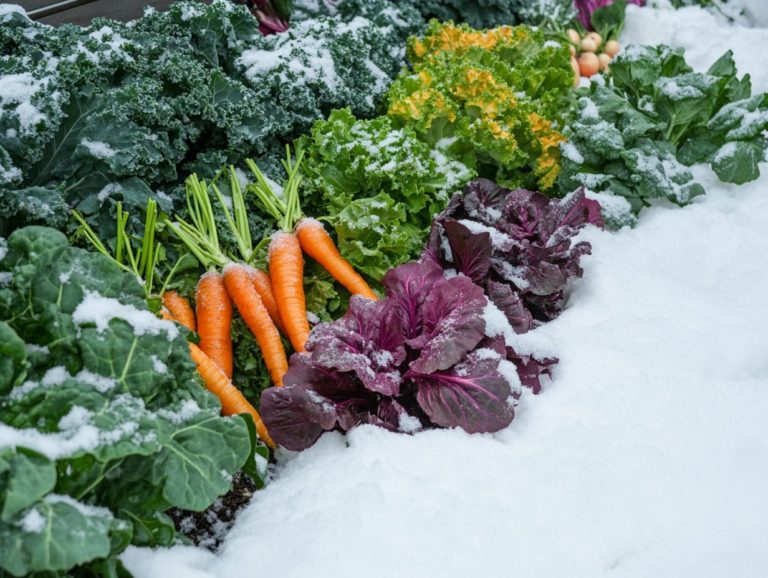How to Prepare Your Soil for Winter Crops
Winter crops present a remarkable opportunity for farmers and gardeners. They enhance yield and boost soil health during colder months.
This discussion covers winter crops. It highlights their benefits and outlines important steps for preparing your soil.
You will learn how to select crops suited to your climate. You ll also discover how to maintain them and avoid common mistakes.
Whether you re a seasoned farmer or just starting, this guide gives you the knowledge to excel in winter gardening.
Contents
- Key Takeaways:
- Understanding Winter Crops
- Benefits of Winter Crops
- Preparing Your Soil for Winter Crops
- Choosing the Right Crops for Winter
- Tips for Maintaining Winter Crops
- Common Mistakes to Avoid
- Frequently Asked Questions
- What are winter crops and why do I need to prepare my soil for them?
- When is the best time to prepare my soil for winter crops?
- How do I know if my soil is suitable for winter crops?
- What are some ways I can improve my soil for winter crops?
- Do I need to remove any leftover plants or debris before preparing my soil for winter crops?
- What are some other tips for preparing my soil for winter crops?
Key Takeaways:
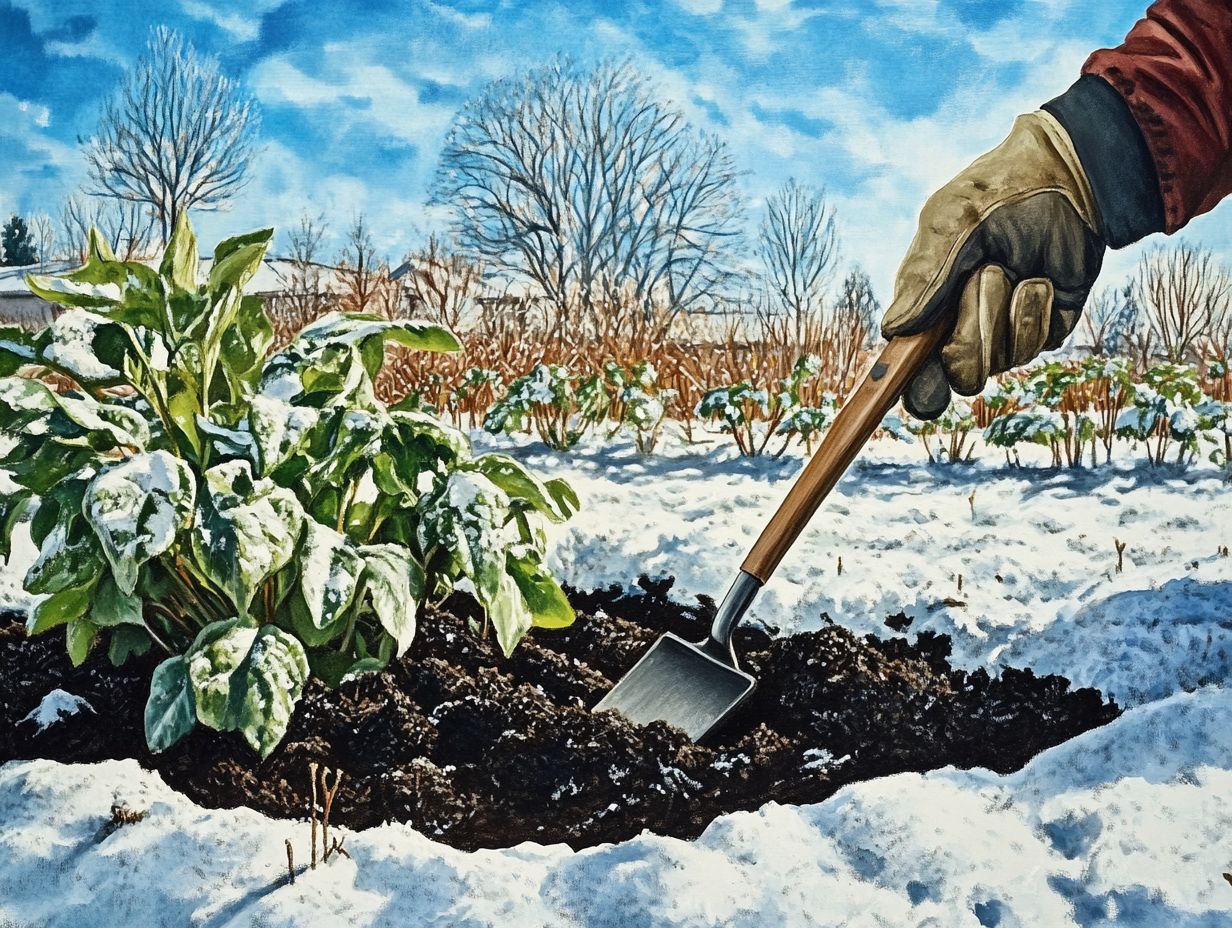
- Winter crops are plants that thrive in cold, providing fresh harvests in winter.
- They help the soil by reducing erosion, increasing nutrients, and supporting beneficial organisms.
- Prepare your soil by clearing debris, adding organic matter, and protecting against frost.
Understanding Winter Crops
Understanding winter crops is crucial for gardeners aiming to extend their gardening season and achieve a fruitful harvest even in the chillier months. Winter crops present special benefits, allowing you to cultivate nutrient-rich soil that stands resilient against frost and other harsh conditions.
By thoughtfully selecting crops like garlic and specific legumes, you can boost your soil’s health and structure, ensuring your garden stays vibrant and productive throughout the winter. Moreover, familiarizing yourself with the best practices and techniques for planting and maintaining these crops can profoundly influence your overall gardening success.
What are Winter Crops?
Winter crops are specialized plants that thrive during the colder months. They are designed to endure frost while offering vital nutrients to the soil and a bountiful harvest for you, the gardener.
Take garlic and certain hardy vegetables, for example; they flourish in these brisk conditions, demonstrating their remarkable resilience while enriching the soil. These crops enhance soil structure and fertility through their robust root systems, effectively locking nutrients in place.
It s crucial for you to consider local frost dates when planning your planting schedule. This knowledge dictates the ideal timing for sowing your seeds. Choosing organic seeds not only champions sustainable practices but also boosts the overall health of your crops, making winter gardening a truly rewarding and environmentally conscious endeavor.
Benefits of Winter Crops
The advantages of winter crops reach far beyond just their harvest; they are essential for maintaining and enhancing your soil, ensuring your garden thrives year-round.
By integrating winter crops into your gardening routine, you can greatly boost the nutrient-holding capacity of your soil. This results in richer organic matter and reduced risk of plant diseases in the upcoming growing seasons.
Moreover, these crops play a crucial role in preventing soil erosion and suppressing weeds, fostering a cleaner and more manageable garden environment.
Advantages for Soil and Harvest
One of the standout benefits of winter crops is their ability to enrich the soil with organic matter. This fosters healthier plants and ensures a bountiful harvest in spring.
By incorporating cover crops like winter rye or clover, you can significantly enhance your soil’s structure and fertility. These crops prevent erosion and suppress weeds. When tilled back into the soil, they break down and release essential nutrients for vigorous growth.
The increase in organic matter not only nourishes your soil but also helps retain moisture an essential ingredient for cultivating healthy vegetables.
If you’re keen on maximizing your harvest from these winter crops, practicing crop rotation and maintaining a balanced pH can greatly boost your yields. Crop rotation means changing the type of plants grown in an area each season. Keeping a balanced pH ensures your soil is not too acidic or too alkaline, which is essential for healthy plant growth.
Additionally, mulching around your plants will help regulate temperature and moisture levels. This creates an environment where your garden can truly thrive come spring.
Preparing Your Soil for Winter Crops

Get your soil ready now for a thriving winter garden! Preparing soil for early spring planting ensures it is rich in the nutrients your plants need to grow strong.
Preparing your soil for winter crops is essential for maintaining a productive garden throughout the year, especially by keeping your soil healthy in winter to ensure it is teeming with the nutrients crucial for your plants’ growth.
Start with a soil test; this initial step will help you evaluate the nutrient content and pinpoint any amendments needed to cultivate a nutrient-rich foundation for your fall planting. Consider incorporating cover crops into your strategy. Not only do they shield the soil, but as they decompose, they enrich the soil with organic matter, significantly improving its health and structure.
Steps for Preparing Soil
To prepare your soil for winter crops successfully, there are several key steps you should take, including preparing your planting beds for winter, to optimize its quality and readiness for planting.
- Begin by testing the soil to gain insight into its pH levels and nutrient composition; this information will guide your choices for amendments.
- Once you receive the test results, enrich the soil by incorporating compost and organic matter, enhancing both its fertility and structure.
- Proper drainage is crucial, so take a moment to evaluate your plot’s layout and make any necessary adjustments. Raised beds can be an excellent solution for improving drainage.
- In terms of effective composting, layering brown and green materials will accelerate the process while maintaining adequate moisture levels to promote decomposition.
- Lastly, always use clean tools to safeguard against diseases and pests that could jeopardize your crops, ensuring a healthier growing environment.
Choosing the Right Crops for Winter
Selecting the right crops for winter is crucial for optimizing your garden’s success. This choice enhances the likelihood of a bountiful harvest and ensures that your plants can endure frost and cold temperatures with resilience.
Factors to Consider
When selecting crops for winter planting, there are several key factors to consider if you want to achieve a successful yield while minimizing the risk of pests and diseases.
Know your local climate. Cooler temperatures can dictate which plants will thrive. Soil health is also critical its nutrient content and structure directly influence plant strength and resilience. Nutrient-rich soil sets the stage for robust growth.
Being aware of potential pests that may linger during the colder months allows you to devise effective protection strategies. Incorporating crop rotation helps maintain soil fertility and disrupts pest cycles.
By taking all these factors into account, you can make informed decisions on crop varieties and growing methods, ultimately cultivating a vibrant winter garden.
Tips for Maintaining Winter Crops
Maintaining winter crops demands a refined set of best practices to guarantee their health and productivity during the colder months. Following the essential steps for preparing your garden for winter nurtures your current crops and prepares your garden for the forthcoming planting season.
Best Practices for Growing and Harvesting
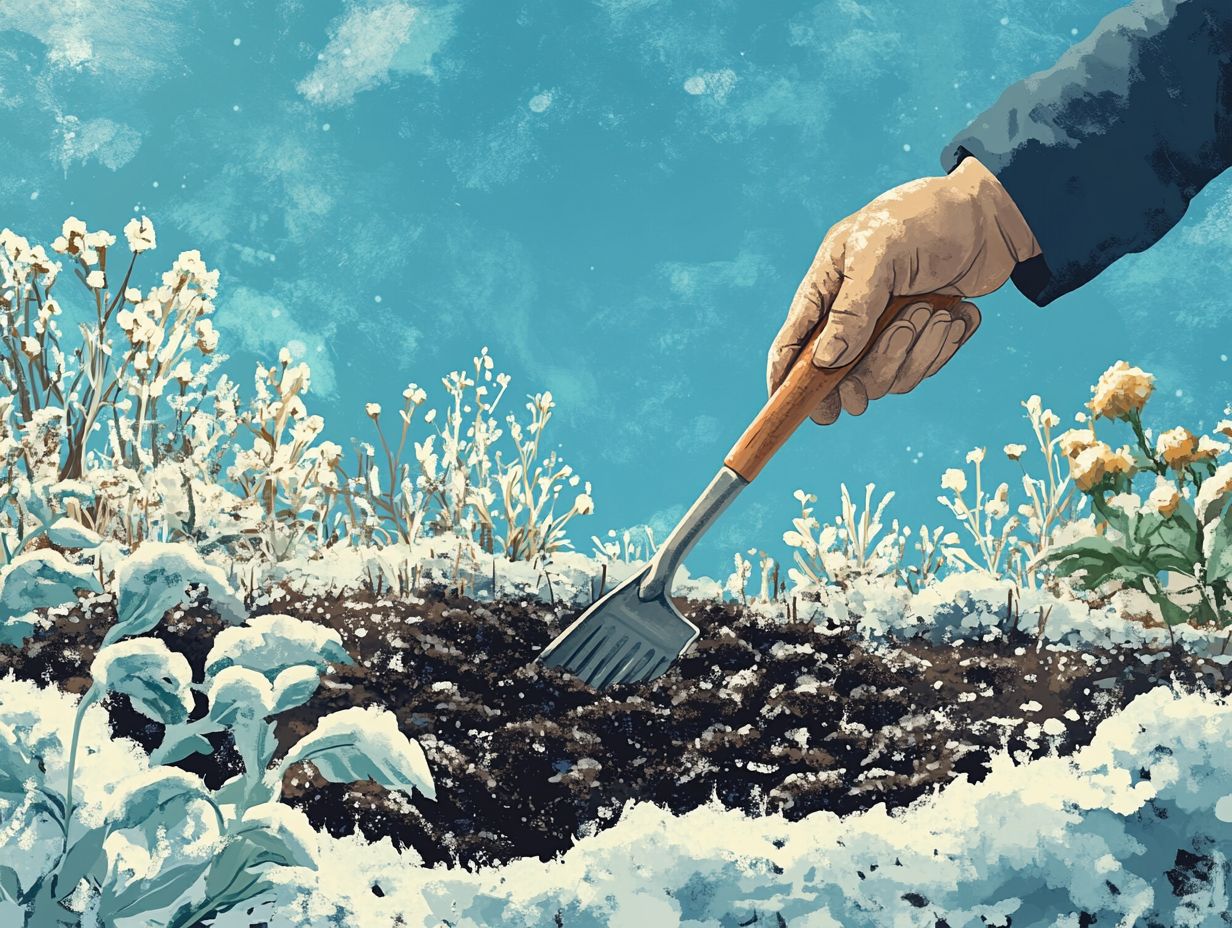
Implementing best practices for growing and harvesting winter crops can significantly elevate your gardening experience, ensuring a bountiful yield even in the cold weather.
By incorporating organic compost into your soil, you provide essential nutrients that foster healthy growth during those chillier months. Effective mulching techniques are also vital; they help retain moisture and regulate soil temperature, creating a welcoming environment for your winter crops.
It s equally important to adopt appropriate watering methods, like drip irrigation, to minimize water stress during frosty spells. Timing is everything when it comes to harvesting understanding the right moment to reap your rewards is crucial for maximizing flavor and nutritional value.
These practices work together to enhance your gardening success, enabling you to thrive in your winter gardening endeavors.
Start preparing your winter garden today for a successful harvest tomorrow! Don’t wait; get your soil ready by following this guide to preparing soil for fall planting and choose the right crops for this season.
Common Mistakes to Avoid
Grasping the common mistakes to avoid when cultivating winter crops is essential for maintaining a thriving garden and securing successful harvests throughout the colder months.
Being aware of these pitfalls enables you to care for your plants effectively, ensuring your garden flourishes even in the chill.
Potential Pitfalls and How to Avoid Them
There are several potential pitfalls when it comes to growing winter crops. However, with the right knowledge and strategies, you can easily steer clear of them.
One of the most common challenges you might encounter as a beginner gardener is inadequate preparation. This can lead to stunted growth or, worse, a complete harvest failure. Taking the time to properly test and improve your soil before planting can make all the difference in your success.
Pest control is equally crucial during the winter months; pests don’t just disappear with the cold. By employing effective solutions like companion planting and natural repellents, you can protect your crops and ensure they thrive.
Keeping your gardening tools clean is crucial to prevent the spread of plant diseases. Regularly sanitizing your tools and practicing good maintenance habits will help you cultivate a flourishing winter garden and ensure healthy vegetables.
Frequently Asked Questions
What are winter crops and why do I need to prepare my soil for them?
Winter crops are plants specifically grown during the colder months of the year. They are important for maintaining a healthy and productive garden all year round. For these crops to thrive, it is essential to properly prepare your garden soil beforehand.
When is the best time to prepare my soil for winter crops?
The best time to prepare your soil for winter crops is in the late summer or early fall, before the first freeze. Understanding soil needs for winter vegetables allows enough time for any necessary improvements to take effect and for the soil to settle before fall planting.
How do I know if my soil is suitable for winter crops?
The first step is to test your soil’s pH level. Most winter crops prefer neutral or slightly acidic soil. You can purchase a soil test kit or have your soil professionally tested. Additionally, using mulch to protect winter crops can further enhance your garden’s health. If your soil is too acidic, you can add lime to raise the pH level and improve the nutrient-holding capacity of your garden.
What are some ways I can improve my soil for winter crops?
One way to improve your garden soil for winter crops is by adding organic compost or aged manure. This will help improve the soil structure, increase nutrient levels, and promote better drainage. Additionally, preparing soil for cold-weather perennials can enhance your garden’s performance. You can also add mulch to help retain moisture and regulate soil temperature.
Do I need to remove any leftover plants or debris before preparing my soil for winter crops?
Yes! Be sure to clear out dead plants and debris to keep your garden healthy. This will help prevent pests and diseases from overwintering and potentially damaging your crops. Effective garden cleanup can include creating a compost pile with the plant material or disposing of it properly.
What are some other tips for preparing my soil for winter crops?
In addition to soil testing and improving soil, it is also important to till or turn over the soil to a depth of 8-12 inches. This will help mix in any amendments and loosen the soil for better root growth. It is also helpful to plan out your crop rotation and choose winter crops suitable for your region and climate.
Prepare your soil now to ensure a vibrant winter harvest! For detailed advice, check out preparing your garden for winter and start your winter gardening journey today. Share your successes with others!

